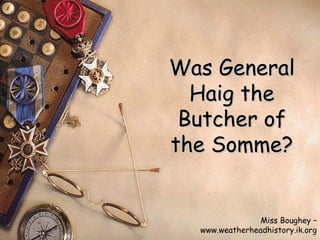
Battle of the somme
- 1. Was General Haig the Butcher of the Somme? Miss Boughey – www.weatherheadhistory.ik.org
- 2. July 1st 1916 The Battle of the Somme started on July 1st 1916. It lasted until November 1916. For many years those who lead the British campaign have received a lot of criticism for the way the Battle of the Somme was fought – especially General Sir Douglas Haig. This criticism was based on the appalling casualty figures suffered by the British and the French. General Haig – the man who planned the Battle of the Somme.
- 3. Douglas Haig has been blamed for the slaughter of thousands of men who were under his control in World War One. The Battle of the Somme was one of his worst fights were 60,000 British soldiers died in the first day alone. After the Battle of the Somme, Haig got the nickname "Butcher of the Somme“. He was given this nickname because some people felt that Haig had not cared how much ground was gained for the heavy loss of British life. Was this a fair nickname? Haig had been ordered to launch the offensive to let the French recover at Verdun, where there was heavy fighting.
- 4. By the end of the battle of the Somme, the British Army had suffered 420,000 casualties, the French lost 200,000 soldiers and the Germans lost almost 500,000 soldiers during the Battle of the Somme. 60,000 British soldiers died on the first day of the battle alone. This was the worst day of fighting in British history. More German soldiers died than British soldiers at the Battle of the Somme. Surely this shows that Haig’s plan was partially Successful!
- 5. Ironically, going over the top at the Somme was the first taste of battle many of these men had, as many were part of "Kitchener’s Volunteer Army" persuaded to volunteer by posters showing Lord Kitchener himself summoning these men to arms to show their patriotism . Britain had never experienced a War of stalemate before. Living in trenches and fighting In No Man’s Land was a New experience.
- 6. The battle at the Somme started with a weeklong artillery bombardment of the German lines. 1,738,000 shells were fired at the Germans. The logic behind this was so that the artillery guns would destroy the German trenches and barbed wire placed in front of the trenches. Bombardment Haig genuinely felt that this tactic would work. He had been advised that barbed wire in No Man’s Land would be destroyed by the shells.
- 7. Safe Underground In fact, the Germans had deep dugouts for their men and all they had to do when the bombardment started was to move these men into the relative safety of the deep dugouts. When the bombardment stopped, the Germans would have known that this would have been the signal for an infantry advance. They moved from the safety of their dugouts and manned their machine guns to face the British and French.
- 8. The Allied troops climbed out of their trenches and moved over no mans land towards the German front lines. Many were gunned down in no man’s land. However due to the huge number of troops attacking the German line soldiers did get through. They were followed by cavalry. This was not a great success. The muddy conditions made horses a slow and riders easy targets. The man to man combat that followed was bloody and horrific. Haig had been a successful British Commander many times. Using cavalry was a traditional and successful method of attacking. Nobody was used to this new modern warfare.
- 9. In just five months the Allied forces had advanced along a thirty-mile strip that was seven miles deep at its maximum. Lord Kitchener was a supporter of the theory of attrition - that eventually you would grind down your enemy and they would have to yield . He saw the military success of the battle as all-important. However, it did have political and social consequences in Britain. Many spoke of the " lost generation ". Many people found it difficult to justify the near 88,000 Allied men lost for every one mile gained in the advance.
- 10. Butcher? Did Haig see the soldiers of the British Army as nothing more than pawns in his vain glory search. Was Haig unbending in his belief in the 'big push' theory that one major victory would end the war. The loss of hundreds of thousands of soldiers was simply a statistic of war in the mind of this man. The Battle of the Somme was not the first time Haig had tried the tactic of bombardment. Haig continued to send men into the Somme battlefield for four months even when it was obvious that the plan was a disaster.
- 11. Hero? Haig was faced with an impossible dilemma in a war that no-one was prepared for or able to win on the battlefield. Haig was under constant pressure from the British Government for a morale boosting victory over the Germans. It was not considered acceptable to simply sit in the trenches of the Western Front and wait for the Germans to give in. In 1916 the Germans were attacking the French fortress of Verdun. By attacking the Germans on the Somme, Haig was able to relieve the pressure on the French at Verdun.
- 13. What do You Think? Butcher or Hero?
Notes de l'éditeur
- This presentation can be used as either an introduction or revision exercise on propaganda.
- It will take at least two lessons to complete this exercise. I would advise people to just use the slides that they feel most appropriate.